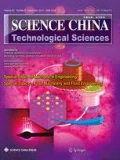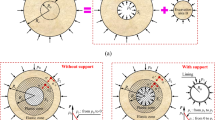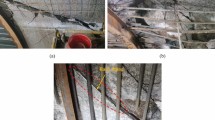Abstract
As a main constituent of geological body, the rock masses have distinct differences from other materials, one of which is that rock masses are initially stressed in their natural states. Hence, it is an extremely challenging and significant research project to know the present residual stress of the rock masses in the earth’s crust. Although some regularities of distribution of in-situ rock stresses can be deduced, the basic means to study the state of rock stress is in-situ stress measurement. After a brief review of several measuring methods of in-situ 3D rock stress, a new one, borehole wall stress relief method (BWSRM) to determine the in-situ 3D rock stress tensor in a single drilled borehole was proposed. Based on the principle of in-situ rock stress measurement with BWSRM, an original geostress measuring instrument was designed and manufactured. Preliminary experiments for determination of in-situ stress orientation and magnitude were carried out at an experimental tunnel in Jinping II hydropower station in China, where the buried depth of overburden was about 2430 m. The results showed that it was feasible to measure the in-situ 3D rock stresses with BWSRM presented in this paper. The BWSRM has a broad prospect for in-situ 3D rock stress measurements in practical rock engineering.
Similar content being viewed by others
References
Emmermann R, Lauterjung J. The german continental deep drilling program KTB: Overview and major results. J Geophys Res, 1997, 102: 18179–18201
Brudy M, Zoback M D, Fuchs K, et al. Estimation of the complete stress tensor to 8 km depth in the KTB scientific drill holes: Implications for crustal strength. J Geophys Res, 1997, 102: 18453–18475
Haimson B C, Cornet F H. ISRM Suggested Methods for rock stress estimation—Part 3: Hydraulic fracturing (HF) and/or hydraulic testing of pre-existing fractures (HTPF). Int J Rock Mech Min Sci, 2003, 40: 1011–1020
Sjöberg J, Christiansson R, Hudson J A. ISRM suggested methods for rock stress estimation—Part 2: Overcoring methods. Int J Rock Mech Min Sci, 2003, 40: 999–1010
Amadei B, Stephansson O. Rock Stress and its Measurement. London: Chapman & Hall, 1997
Cai M F, Qiao L, Li H B. Rock Stress Measurement Principles and Techniques (in Chinese). Beijing: Science Press, 1995
Liu Y F. Rock Stress and Engineering Construction (in Chinese). Wuhan: Hubei Scientific and Technological Press, 2000
Fairhurst C. Stress estimation in rock: A brief history and review. Int J Rock Mech Min Sci, 2003, 40: 957–973
Ljunggrena C, Chang Y, Janson T, et al. An overview of rock stress measurement methods. Int J Rock Mech Min Sci, 2003, 40: 975–989
Wang L J, Pan L Z, Liao C T, et al. Geostress Measurement and its Application in Engineering (in Chinese). Beijing: Geological Publishing House, 1991
Sugawara K, Obara Y. Draft ISRM suggested method for in-situ stress measurement using the compact conical-ended borehole overcoring (CCBO) technique. Int J Rock Mech Min Sci, 1999, 36: 307–322
Oikawa Y, Matsunaga I, Yamaguchi T. Differential strain curve analysis to estimate the stress state of the Hijiori hot dry rock field, Japan. Int J Rock Mech Min Sci Geomech Abstr, 1993, 30: 1023–1026
Brudy M, Zoback M D. Drilling-induced tensile wall-fractures: Implications for determination of in-situ stress orientation and magnitude. Int J Rock Mech Min Sci, 1999, 36: 191–215
Lavrov A. The Kaiser effect in rocks: Principles and stress estimation techniques. Int J Rock Mech Min Sci, 2003, 40: 151–171
Ge X R, Hou M X. New approach to measure geostress—local borehole-wall complete stress relief method (in Chinese). Chinese J Rock Mech Eng, 2004, 23: 3923–3927
Ge X R, Hou M X, Wang S L. A new approach for measuring the in-situ 3D rock stress tensor in drilled borehole. In: Proceedings of International Symposium on In-situ Rock Stress, Trondheim, Norway, 19–21 June 2006. In: Ming L, et al., eds. London: Taylor & Francis/Balkema, 2006. 185–192
Hiramatsu Y, Oka Y. Determination of the stress in rock unaffected by boreholes or drifts from measured strains or deformations. Int J Rock Mech Min Sci Geomech Abstr, 1968, 5: 337–353
Hou M X, Ge X R. Study on a calculation model for the in-situ 3D crustal stress tensor (in Chinese). Rock Soil Mech, 2007, 28: 2017–2021
Wu S Y, Shen M B, Wang J. Jinping hydropower project: Main technical issues on engineering geology and rock mechanics. Bull Eng Geol Environ, 2010, 69: 325–332
Author information
Authors and Affiliations
Corresponding author
Rights and permissions
About this article
Cite this article
Ge, X., Hou, M. Principle of in-situ 3D rock stress measurement with borehole wall stress relief method and its preliminary applications to determination of in-situ rock stress orientation and magnitude in Jinping hydropower station. Sci. China Technol. Sci. 55, 939–949 (2012). https://doi.org/10.1007/s11431-011-4680-x
Received:
Accepted:
Published:
Issue Date:
DOI: https://doi.org/10.1007/s11431-011-4680-x




